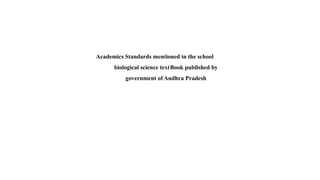
Academic standards in Biological science text books.pptx
- 1. Academics Standards mentioned in the school biological science textBook published by government of Andhra Pradesh
- 2. Introduction: Academic standards are the benchmarks of quality and excellence in education such as the rigour of curricula and the difficulty of examinations. The creation of universal academic standards requires agreement on rubrics, criteria or other systems of coding academic achievement. At colleges and universities, faculty are under increasing pressure from administrators to award students good marks and grades without regard for those students' actual abilities, both to keep those students in school paying tuition and to boost the schools' graduation rates. Students often use course evaluations to criticize any instructor who they feel has been making the course too difficult, even if an objective evaluation would show that the course has been too easy.
- 3. Purpose of Academic standards: Standards spell out what students are expected t learn in each grade and each subject. These standards become the basis for the for the way teachers are trained, what they teach and what is on state standardized tests that students take. Standards ensure better accountability – holding teachers and schools responsible for what goes on in the classrooms. The practice of aligning learning to standards also helps ensure that a higher level of learning is attained, guides teachers in the process of assessment and helps keep them on track. In education the term standards –based refers to systems of instruction, assessment, grading and academic reporting that are based on students demonstrating understanding or mastery of the knowledge and skills they are expected to learn as they progress through their education.
- 4. Academic standards mentioned in biological science Text books: 1. Conceptual understanding: Children are able to explain, cite examples, give reasons, and give comparison and differences, explain the process of given concepts in the textbook. Children are able to develop their own brain mappings. 2. Asking questions and making hypothesis: Children are able to ask questions to understand, to clarify the concepts and to participate in discussions. They are able to make hypothesis on given issues. 3. Experimentation and field investigation: To understand given concepts in the textbook children are able to do experiments on their own. They are able to participate in field investigation and making reports on them. 4. Information skills and Projects: Children are able to collect information (by using interviews, internet etc.) and analyses systematically. They are able to conduct their own project works.
- 5. Contd…….. 5. Communication through drawing, model making: Children are able to explain their conceptual understanding by drawing figures and making models. Able to plotting graphs by using given information or collected data. 6. Appreciation and aesthetic sense, values: Children are able to appreciate man power and nature, and have aesthetic sense towards nature. They are also able to follow constitutional values. 7. Application to daily life, concern to biodiversity: Children are able to utilize scientific concept to face their daily life situations. They are able to show concern towards bio diversity The above-mentioned academic standards are to be accomplished as learning outcomes in science education. Each academic standard and their outcomes are discussed in detailed.
- 6. Weightages given to Academic standards:
- 7. 1. Conceptual understanding: Weightage given :40% Type of questions that can be asked: Define the following… Eg. Define nutrition. Classify……. Eg. Classify the animal kingdom
- 8. 2. Asking, Questioning and Making Hypotheses: Weightage given :10% Students need to frame questions based on the given situations and events. Eg. Your friend is asked to differentiate between deforestation and afforestation. Which questions would you ask your friend to know about the two. Asked to hypothesize on given conditions Eg. Imagine and write what happens if carbon dioxide levels increase enormously in the atmosphere.
- 9. 3. Experimentation and field investigation Weightage given :5 to 10% Activity based questions were asked: What is the aim of an activity? Eg.What is the aim of food preservation. What are the chemicals required? Eg. What are the chemicals required in starch test.
- 10. Preparation of Boiled Rice Preparation of food in plants Raw materials Rice, water Chlorophyll, carbon dioxide water sources Fire sunlight Place of preparation Vessel Chloroplast 4. Information skills and projects: Weightage given :15% Tabular form questions were asked:
- 11. 5.Communication through drawing and model making: Weightage given :10% Picture based questions were asked. Draw a neat labelled diagram of chloroplast and label its parts.
- 12. 6. Appreciation and Aesthetic Sense /Value: Weightage given :10% Following type of questions were asked: Appreciating a science phenomenon or a scientist Eg. Write about the hardship of any scientist on their way to discover things.
- 13. 7. Application to daily life / Concern to biodiversity: Weightage given :10 -15% Questions which relate science concepts which relate to daily life. Application of scientific phenomenon in daily life.